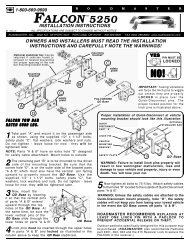tow bars - Roadmaster Inc.
tow bars - Roadmaster Inc.
tow bars - Roadmaster Inc.
Create successful ePaper yourself
Turn your PDF publications into a flip-book with our unique Google optimized e-Paper software.
74<br />
Attaching the safety cables To connect EZ Hook safety cables…<br />
Some ROADMASTER <strong>tow</strong> bar mounting brackets<br />
with removable arms, such as the ones shown<br />
in Figures 1, 3 and 6, use both a long safety cable<br />
and a short (or, ‘bracket’) safety cable on each side. Each<br />
long safety cable runs from the motorhome to a quick link<br />
attaching it to one of the quick-disconnects. This quick<br />
link is also an attachment point for one of the short safety<br />
cables; another quick link attaches the short safety cable<br />
to the receiver brace on the mounting bracket.<br />
Unscrew the nuts on each quick link to connect the<br />
safety cable loops. Finger-tighten the nuts firmly, until the<br />
loop is completely closed, to secure the attachment.<br />
Do not substitute carabiners or other devices for the<br />
quick links — the quick links are designed to hold the<br />
weight of a <strong>tow</strong>ed vehicle; carabiners or other devices<br />
are not.<br />
Only ROADMASTER <strong>tow</strong> bar brackets with removable<br />
arms have this three-point attachment system (with<br />
the exception of MX brackets). Other brackets, such as<br />
ROADMASTER standard and MS brackets, and those of<br />
other manufacturers, are bolted directly to the frame of the<br />
<strong>tow</strong>ed vehicle and do not require short safety cables.<br />
Figure 1 shows the short safety cable attachment for<br />
a typical XL single-hook safety cable system; Figure 3<br />
shows an EZ Twistlock safety cable system. (For doublehook<br />
safety cables, use the quick links at the bottom of<br />
the QDs as attachment points for the hooks.)<br />
If the <strong>tow</strong>ed vehicle is equipped with Standard, MX<br />
or MS brackets — the short (‘bracket') safety cables are<br />
not used with these brackets (except, if necessary, to<br />
extend the length of the long cables). For MX and MS<br />
Standard and MS bracket attachments<br />
continued from preceding page<br />
extensions, and to attach the <strong>tow</strong> bar to the QDs, refer<br />
to the owner’s manual and/or the installation instructions.<br />
(Owner’s manuals and installation instructions are available<br />
at www.roadmasterinc.com. Or, call ROADMASTER<br />
customer service at 800-669-9690 to request a copy.)<br />
Attach the long safety cables (Figure 5) to the QDs<br />
with the quick links (Figure 5). Pre-drilled holes are provided<br />
at the bottom of the QDs for this purpose.<br />
Refer to “Attaching the safety cables” for additional<br />
information.<br />
Figure 5<br />
At the <strong>tow</strong> bar, connect each long safety cable to a<br />
cable anchor bracket by inserting the ball through the<br />
top of the slot and dragging it down. Attach the quick<br />
link for the short safety cable through the pre-drilled<br />
hole in the anchor bracket.<br />
Note: EZ Hook safety cables cannot be used with<br />
ROADMASTER MX or MS <strong>tow</strong> bar brackets.<br />
Figure 6<br />
brackets, the connection point at the <strong>tow</strong>ed vehicle varies;<br />
it may be located on the receiver brace (as shown in<br />
Figure 4) or on another part of the <strong>tow</strong> bar bracket which<br />
is not removable.<br />
WARNING<br />
The safety cables must be carefully routed so that<br />
they cannot become pinched, frayed, scraped or otherwise<br />
damaged, and so they will not drag when going<br />
over dips or low spots. Do not use the cables if they<br />
show any signs of wear or damage — immediately<br />
discontinue <strong>tow</strong>ing and replace the cables.<br />
Failure to replace worn or damaged safety cables<br />
will result in cable failure, which may cause property<br />
damage, personal injury or even death.<br />
WARNING<br />
If the quick links are not completely tightened, with<br />
the loop closed, the safety cables may detach. In the<br />
event of a <strong>tow</strong>ing system failure, the <strong>tow</strong>ed vehicle will<br />
detach, which may cause property damage, personal<br />
injury or even death.<br />
WARNING<br />
If your <strong>tow</strong>ing system requires two sets of safety<br />
cables, always use both the long and the short safety<br />
cables. Connect them as shown in Figures 1, 3 and 6.<br />
Otherwise, in the event of a <strong>tow</strong>ing system failure, the<br />
<strong>tow</strong>ed vehicle will detach, which may cause property<br />
damage, personal injury or even death.<br />
WARNING<br />
The weight of the <strong>tow</strong>ed vehicle, including all its<br />
contents, cannot exceed the weight capacity of the<br />
safety cables, or the safety cables will fail, which<br />
may cause property damage, personal injury or even<br />
death.





